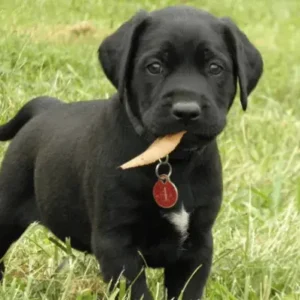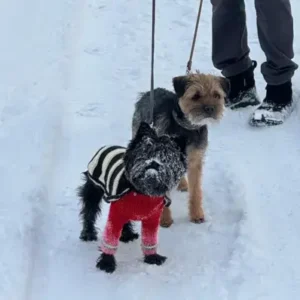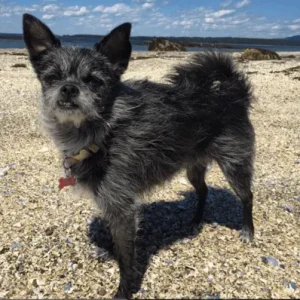Brussels Griffon History/Origin
Griffon-type dogs have been known in Europe for centuries. In Jan van Eyck’s famous 1434 painting of the ‘Arnolfini Couple,’ you can see an early version of the Griff. This early version had a longer muzzle than the flatter-faced ones we see today.
The true history of the Griffs begins in the early 1800s in Brussels, Belgium, where they transitioned from rough rat catchers to sophisticated companions.
Coachmen in Brussels kept small terrier-like dogs, called “griffons d’ecurie,” to control rats in their stables. These purebred dogs were similar to Affenpinscher, and the drivers experimented with different breeds to improve them.
Although no records exist of these breedings, it’s believed that the Pug, English Toy Spaniel, an old Belgian breed called the Brabancon, and possibly Yorkshire Terrier contributed to the Brussels Griffon’s development.
Brussels Griffon History- Source: AKC.org
A major change in the breed’s history occurred in the 1870s when Queen Henrietta Maria of Belgium became fond of them.With her support, the Griff gained popularity among the royal court. This increased interest led to efforts aimed at making the dogs smaller.
Breeders also worked to give them more human-like faces. Historically, these charming dogs were known as coated stable dogs, originally bred for their roles in stables.
This royal attention sparked international interest, and Griffons were shipped to England and America. The American Kennel Club AKC registered its first Griff under Toy Group in 1910. Sadly, both world wars significantly reduced the Griff population, and without the dedication of enthusiasts in the U.S. and Britain, the breed might have vanished.
Brussels Griffon Personality
Brussels Griffon’s temperament is known for their charming and distinctive personalities. These small dogs can range from outgoing and energetic to reserved and shy, but most fall in between.
While they can be a bit bossy, they are incredibly affectionate and thrive on human companionship, forming strong bonds with their owners.
- Potential Challenges
Brussels Griffon is one of the dog breeds that can present several potential challenges for owners, primarily due to their unique temperaments and needs. Their personalities can vary widely, which may lead to behavioral issues if not managed properly.
For instance, they can be stubborn and may require a consistent training approach that emphasizes positive reinforcement, as harsh methods could backfire.
Early socialization is crucial; without exposure to various people, pets, and environments, they might develop shyness or fearfulness. Additionally, their strong attachment to their owners—often referred to as “Velcro dogs”.
It means they may exhibit separation anxiety if left alone for extended periods, leading to misbehavior. Understanding these challenges and addressing them with patience and care is essential for fostering a well-adjusted Brussels Griffon.
Brussels Griffon Physical Appearance
The Brussels Griffon is a compact, squarely proportioned toy dog breed. It has medium-length, muscular front legs with strong thighs. Its feet are small and round, featuring black pads and arched toes. One of its most striking features is the large, widely spaced eyes with long black lashes. These eyes give the Griffon an expressive, almost human-like look. The breed has small ears set high, which can be left natural or cropped. Its head is large and round, with a dome-shaped forehead.
- Brussels Griffon Size
The Brussels Griffon typically stands between 7 to 10 inches tall and weighs between 8 to 10 pounds. Their small size makes them well-suited for various living environments, including apartments. This compact stature adds to their charm and endearing appeal.
- Coat color
The Brussels Griffon breed features two distinct types of coats: the Rough Coat Griffon and the Smooth Coat. The Rough Coat Griffon has a dense, wiry coat with slightly longer hair around the eyes, cheeks, and chin, always appearing neat.
In contrast, the Smooth Coat Brussels Griffon has a short, glossy coat that lies close to the body without any wiry hair.
This breed comes in four colors: Red, Belge, Black, and Tan and Black. Mature Griffons may develop a gray muzzle, but they should not have any white hairs.
Red Brussels Griffon- Source: AKC.org
Belge Brussels Griffon- Source: AKC.org
Black Brussels Griffon- Source: puffthemagicgriffon
Wheaten Brussels Griffon- Source: brusselsgriffonnews
Brussels Griffon Gender Differences
Male and female Brussels Griffons exhibit a few notable differences. Typically, males are slightly larger than females, both in height and weight. While both genders share the same charming personality traits, the size variation can influence their appearance and presence.
Brussels Griffon Feed/Nutrition
The recommended daily amount of high-quality dry food for your Brussels Griffon is 1 cup, split into two meals. However, the actual amount your adult dog requires may vary based on factors such as size, age, build, metabolism, and activity level.
Just like people, dogs are individuals with different nutritional needs. Highly active dogs will naturally require more food than those that are less active. Tomatoes can be given in moderation, but make sure to remove the stems and leaves, as they can be toxic to dogs.
The quality of dog food you choose is also important. Selecting a better-quality dog food ensures it provides more nourishment, allowing you to feed less while still meeting your dog’s needs.
To keep your Griffon in good shape, measure out his food and serve it twice a day instead of free-feeding. Leaving food out all the time can lead to overeating and weight gain.
Brussels Griffon Health
Griffons are generally healthy, but like all breed dogs, they can be prone to certain health issues. Here’s a breakdown of common conditions and how to manage them:
- Hip Dysplasia: This inherited condition occurs when the thighbone doesn’t fit properly into the hip joint, leading to pain, lameness, and arthritis. To minimize the risk, ensure your Griffon maintains a healthy weight and avoid over-exercising young puppies. Always check for hip dysplasia clearances when buying from breeders.
- Patellar Luxation: This happens when the kneecap slips out of place, causing pain and lameness. The condition may require surgery if severe. Regular vet check-ups can help detect it early. Keeping your dog at a healthy weight helps reduce strain on the joints.
- Eye Issues: Due to their prominent eyes, Brussels Griffons are susceptible to irritation, dryness, and scratching. Regular eye cleaning can help prevent infections. If you notice redness or excessive tearing, consult your vet immediately.
- Skin Allergies: Griffons may develop allergies to substances like pollen, dust mites, or certain foods, leading to itching and hair loss. To manage this, bathe your dog with hypoallergenic shampoo and consult your vet for allergy tests to identify triggers.
- Syringomyelia: This serious condition involves fluid-filled cysts forming in the spinal cord, causing pain and sometimes paralysis. While there’s no cure, treatment involves pain management. Always ask for health clearances from breeders to reduce the chances of this condition.
When getting a puppy, it’s essential to request health clearances from the breeder to ensure both parents are free from these conditions. Regular vet visits and a good diet go a long way in keeping your Griffon healthy.
Brussels Griffon Care and Grooming
Rough Coat Griffons need weekly brushing with a natural bristle brush or hound glove, followed by combing with a medium-tooth metal comb. They require “hand stripping” twice a year to promote new coat growth, which also helps reduce scratching and shedding, benefiting those with allergies. A schnauzer clip can be used but won’t maintain the wiry texture.
Smooth Coat Griffons have minimal grooming needs—just weekly brushing and occasional baths. They shed little hair, making them low-maintenance. Regularly brush their teeth and trim their nails once or twice a month.
Brussels Griffons are ideal indoor dogs due to their small size and require regular exercise through daily walks or activities. Being brachycephalic, they are prone to overheating, so provide a cool space in hot weather and watch for signs of heat exhaustion.
Training your dog not to jump is important to prevent them from getting overly excited and potentially injuring themselves or others.
Griffons excel in dog sports like agility and obedience. Use positive reinforcement during training to encourage good behavior.
House training can be challenging, but crate training and consistency can lead to success. Be aware that Griffons may shed seasonally, especially in spring and fall, so prepare for extra grooming during these times.
Brussels Griffon Adoption and Rescue Groups
Rescuing a Brussels Griffon can be a rewarding experience. Many Griffons in shelters need loving homes, and adopting one can provide them with a second chance at happiness. When you rescue, you’re not just saving a dog; you’re gaining a loyal companion who will bring joy and affection to your life.
Brussels Griffon Price
The price of a Brussels Griffon typically ranges from $1,500 to $2,000, depending on factors such as breeder reputation, pedigree, and location.
When considering buying a Brussels Griffon, it’s essential to research reputable breeders who prioritize the health and temperament of their dogs. Purchasing from a responsible breeder ensures that the puppy has been well-cared for and socialized, setting the foundation for a happy and healthy life.
Interesting Facts
- The Brussels Griffon gained many new fans in 1997 when a lively dog named Jill stole the spotlight from Jack Nicholson in the popular movie As Good As It Gets.
As good as it gets- Source: IMDb
- They have appeared in Dog shows such as Breed Judging Show 2024.
Best For
Brussels Griffons are best suited for individuals or families looking for a loving and affectionate companion. Their small size makes them ideal for apartment living, and they thrive on human interaction, making them perfect for those who can dedicate time to bonding and play. They do well with both active individuals who can engage them in fun activities and those who enjoy a quieter lifestyle, as long as they provide the necessary attention and care.
Top Names
| Male Brussels Griffon Names | Female Brussels Griffon Names |
| Oliver | Bella |
| Max | Daisy |
| Charlie | Lily |
| Cooper | Sophie |
| Leo | Zoey |








 Brussels Griffon History- Source:
Brussels Griffon History- Source: 

 Red Brussels Griffon- Source:
Red Brussels Griffon- Source:  Belge Brussels Griffon- Source:
Belge Brussels Griffon- Source:  Black Brussels Griffon- Source:
Black Brussels Griffon- Source:  Wheaten Brussels Griffon- Source:
Wheaten Brussels Griffon- Source: 
 As good as it gets- Source:
As good as it gets- Source: 






